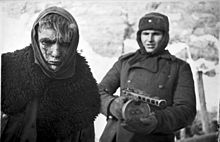Drum magazine
This article needs additional citations for verification. (August 2018) |


A drum magazine is a type of firearm magazine that is cylindrical in shape, similar to a drum. Instead of rounds being stored flat, as in a more common box magazine, rounds in a drum magazine are stored in a spiral around the center of the magazine, facing the direction of the barrel. Probably the first drum magazine to be patented was the one by Salloum Dahdah in 1862. A precursor to the drum magazine was the Accles drum, used for Gatling guns. The first true drum magazine was invented between 1908 and 1915 for the Farquhar–Hill rifle, the patent for which can be found here.
Small arms


There are several primary designs for a drum magazine. The most common is the cylinder type, that has a spider gear assembly that has an opening in each gear for two to three rounds of ammunition and can be loaded from the rear, used primarily in the AK-47. Another common design is the double-stack dual-horn drum, which operates like a standard stick magazine, but diverges the ammo into two separate feed chutes that run on a single cog. Rimmed ammunition including shotgun ammunition operated drums primarily run off a cogged (gear shaped) design which feeds each individual round of the ammo from the outermost edge of the drum. Recently a single-stack compact design has been released, which uses most of the interior capacity of the drum. It is driven by a single hub and telescopic shaft.
The advantage over traditional box-shaped magazines is that a drum magazine can carry much more ammunition, often two to three times that of a box magazine, such as the 71-round drum for the Finnish Suomi KP/-31 and its latter semi-influenced Russian PPSh-41 submachine guns, without making the gun too big to carry easily. Rear-loading drum magazines, such as the 75-round AK-pattern drums manufactured by Norinco, can be left loaded for extended periods of time without having any tension in the spring. The spring is then wound up when the weapon is ready to fire.
The downside to drum magazines is that they increase the overall weight of the weapon in which they are being used. They are also more prone to jamming due to the complex spring mechanisms they contain. Some drums also have a tendency to rattle when they are loaded with ammunition, possibly giving away the user's position.
The most famous Western examples of a firearm using a drum magazine are the iconic 1930s-era Thompson submachine gun and the presently sold semi-automatic copy which had and have both 50 and 100 round drum magazines available for it. The Thompson also has 20 and 30 round box magazines available, demonstrating the difference in carrying capacity between a box and a drum.
More recently double-drum designs have come into greater use. Where normal magazines put rounds in two rows, in a "double drum" two drums resting on either side of the weapon each hold one row, the two of which combine into one row before entering the receiver. Examples are the World War II era MG 15, and the modern Beta C-Mag. These systems have the advantage of storing even more rounds than a regular drum, while improving the distribution of weight.
The most compact of designs released in the early 1990s was the coil magazine, this particular magazine works with non-protruding rimmed ammunition and is currently manufactured for .308 variants like the M14/M1A1, SR-25, FN FAL and HK 91. The design allows for magazines to stack against each other with no separating walls and uses the geometry of the housing to keep the ammunition pressed against each other in a single stack formation.
A 100-round drum magazine was used in the 2012 Aurora shooting in which 12 were killed and contributed to the debate on gun control in the United States.[1][2][3][4][5][6][7][8]
Heavy weapons

The drums of aircraft cannons such as the M61 Vulcan and GAU-8 Avenger resemble drum magazines for small arms, but function in a different manner. That is, the rounds are stored nose-facing-in, and are kept under positive control by partitions running the length of the drum, and are driven forward by an externally powered helical auger. This makes their operation very reliable, even when operated at rates of fire of several thousand rounds per minute.
References
- ^ Dao, James (July 23, 2012). "Aurora Gunman's Arsenal: Shotgun, Semiautomatic Rifle and, at the End, a Pistol". The New York Times. Retrieved August 2, 2018.
The three types of weapons used by the man accused of killing 12 people in a Colorado movie theater — a semiautomatic variation of the military's M-16 rifle, a pump-action 12-gauge shotgun and at least one .40-caliber semiautomatic pistol — are among the most popular guns available in the multibillion-dollar American firearms market...It appears, the police say, that James E. Holmes, the man accused in the Aurora shootings, used all three types of weapons inside the theater as well, first firing the shotgun, then using the semiautomatic rifle until its 100-round barrel magazine jammed, and finishing off with a pistol...much of the public and political attention has been focused on the potential deadliness of the semiautomatic rifle, which law enforcement officials identified as a Smith & Wesson M&P15. The rifle belongs to a class of weapons broadly known as AR-15s, after the original civilian version of the rifle.
- ^ Goode, Erica (December 16, 2012). "Rifle Used in Killings, America's Most Popular, Highlights Regulation Debate". The New York Times. Retrieved August 2, 2018.
In Colorado, officials said Mr. Holmes used a 100-round drum magazine
- ^ Fahrenthold, David A.; Heath, Thomas; Achenbach, Joel (July 22, 2012). "Aurora, Colo., shooting spree: A day of tears for victims and twists in case". The Washington Post. Retrieved August 2, 2018.
Police said the alleged gunman had three weapons: a Remington shotgun, a Smith & Wesson M&P assault rifle and a Glock .40-caliber handgun. The assault rifle, which is akin to an AR-15 and is a civilian version of the military's M-16, could fire 50 to 60 rounds per minute and is designed to hold large ammunition magazines. The source said that Holmes allegedly had obtained a 100-round drum magazine that attached to the weapon but that such large magazines are notorious for jamming. The law enforcement official said authorities think the gunman first used the shotgun — some victims have buckshot wounds — and then began using the assault rifle, which jammed. Then he resorted to the handgun.
- ^ Pearce, Matt (July 22, 2012). "Gun's magazine shaped the pace of Colorado theater massacre". Los Angeles Times. Retrieved August 2, 2018.
The defunct Federal Assault Weapons Ban limited most clip sizes to 10 rounds; police say the theater shooter had a .223-caliber Smith & Wesson AR-15 assault-style rifle with a drum clip that could hold up to 100 rounds and shoot as many as 60 times in a minute.
- ^ Frosch, Dan; Johnson, Kirk (July 20, 2012). "Gunman Kills 12 in Colorado, Reviving Gun Debate". The New York Times. Retrieved July 26, 2018.
He had in the car an AR-15 assault rifle, a Remington 12-gauge shotgun, and a .40 caliber Glock handgun, said Chief Dan Oates of the Aurora police, and all three were believed to have been used inside the theater. Another Glock .40 caliber handgun was recovered inside the theater. Chief Oates said that "many, many" rounds were fired, but that there was no count so far. In the last 60 days Mr. Holmes had purchased four guns at local gun shops, Chief Oates said. And through the Internet, he bought more than 6,000 rounds of ammunition: more than 3,000 rounds for the assault rifle, 3,000 rounds of .40 caliber ammunition for the two Glocks, and 300 rounds for the 12-gauge shotgun. The guns were all bought legally, a federal law enforcement official said. Mr. Holmes also purchased online multiple magazines for the assault rifle, including one 100-round drum magazine. "With that drum magazine, he could have gotten off 50, 60 rounds, even if it was semiautomatic, within one minute," Chief Oates said.
- ^ Candiotti, Susan (July 22, 2012). "Source: Colorado shooter's rifle jammed during rampage". CNN. Retrieved August 3, 2018.
The semi-automatic rifle used in the Colorado theater killings jammed during the rampage, apparently because of a problem with the 100-shot magazine feeding it, a law enforcement source with direct knowledge of the investigation said Sunday. The military-style AR-15 had a separately purchased drum magazine, which can have trouble feeding bullets into the firing chamber if the gun is fired rapidly, the source told CNN...Investigators say the rifle was one of three guns used by Colorado massacre suspect James Holmes in the early Friday killings, along with a shotgun and a .40-caliber pistol. The handgun also had an extended magazine that held 40 rounds
- ^ Jervis, Rick; McAuliff, John (July 24, 2012). "Colo. rampage adds fuel to gun-control debate". USA Today. Retrieved July 30, 2012.
At the core of the debate is the easy access James Holmes, the alleged shooter, had to high-power weaponry, including an AR-15 assault rifle, a 100-round drum magazine capable of shooting more than 50 rounds per minute and more than 6,000 rounds of ammo — all purchased legally at a sporting goods store or over the Internet. Holmes allegedly used that firepower to kill 12 moviegoers and injure 58 early Friday in a crowded theater, according to Aurora police.
- ^ Olinger, David (July 20, 2012). "Aurora gunman carried semi-automatic arsenal to theater". The Denver Post. Retrieved August 3, 2018.
Aurora Police Chief Daniel Oates said Holmes brought a pair of .40-caliber Glock pistols, an AR-15 military-style rifle and a Remington shotgun to the Century Aurora 16 complex, but it was unclear whether he used them all as he strode through the theater, shooting people apparently at random. One Glock pistol was found in his white Hyundai when police arrested him outside the car, he said. Oates said Holmes purchased 6,000 rounds of ammunition and multiple magazines, including a drum magazine able to hold 100 cartridges, from stores and on the Internet


